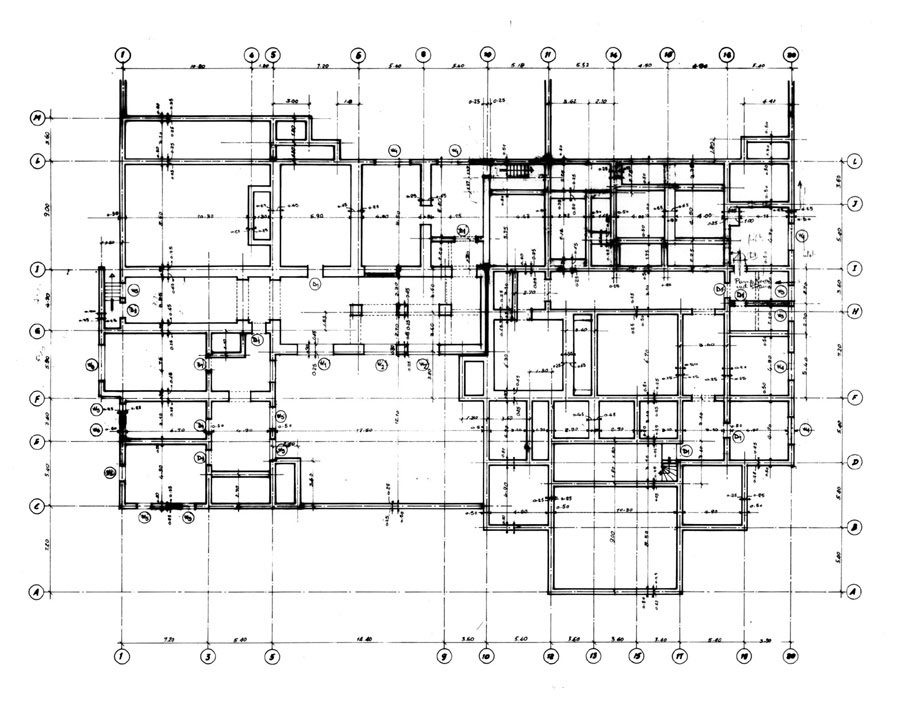Which Of These Four Is Not A Typical Architectural Drawing?

Product information is '...the information prepared by designers, which is passed to a construction team to enable a project to be constructed' (ref. CPIC The importance of production information). Production data is incorporated into tender documentation and and so the contract documents for the construction works.
Production information may include:
- Drawings, such as working drawings.
- Specifications.
- Bills of quantities or schedules of work.
Working drawings provide dimensioned, graphical information that can exist used; past a contractor to construct the works, or by suppliers to fabricate components of the works or to assemble or install components. They may include architectural drawings, structural drawings, civil drawings, mechanical drawings, electrical drawings, and and then on.
Traditionally, working drawings consist of 2-dimensional orthogonal projections of the building or component they are describing, such as plans, sections and elevations. These may be drawn to scale by hand, or prepared using Figurer Aided Design (CAD) software.
Withal, increasingly, building information modelling (BIM) is being used to create three-dimensional representations of buildings and their components for construction. This may be described as a virtual construction model (VCM) and tin contain a number of different models prepared past different members of the project team.
Working drawings may include championship blocks, dimensions, annotation and symbols. Information technology is important that these are consistent with manufacture standards so that their precise meaning is clear and can exist understood. Specification information can be included on working drawings or in a separate specification, but information should not exist duplicated every bit this can go contradictory and may cause confusion.
The scale at which drawings are prepared should reflect the level of detail of the information they are required to convey. Unlike line thicknesses can be used to provide greater clarity for certain elements.
It is of import that the purpose of the drawings and the people that volition use them are considered. Working drawings might be prepared for; statutory approvals, for contractors to program the construction works, to provide instructions on site, for the procurement of components, for the preparation of store drawings, for the appointment of subcontractors and so on.
Drawings must be structured carefully so that they convey necessary information to carry out particular parts of the works. To give greater clarity, they may be separated into packages, then that information is specifically tailored to dissever parts of the works, specific components, or split up suppliers or trades.
Information technology may exist necessary to produce some packages before than others, for example, for items with long manufacturing times such as switchgear, chiller units, lifts, escalators or bespoke cladding systems, or for front-end structure such as service diversions, sabotage, setting out details, underground drainage, piling and groundworks.
The quality of production information is extremely important. Unless it is prepared and co-ordinated properly, there will be disputes and delays on site, and costs will be incurred. Common bug with working drawings include:
- Poor co-ordination of information.
- Errors and omissions.
- Information not getting to the right people.
- Poor presentation.
Responsibility for the preparation of production information volition depend on the selected organisation of procurement and the chosen form of contract. On traditional contracts (and direction contracts and structure direction contracts), production information may be produced by a consultant team, working for the client.
Some specialist elements of production information may be produced past specialist contractors, co-ordinated past the lead designer. On other forms of contract, such as design and build, responsibility for preparing and co-ordinating production information may lie with the main contractor.
Working drawings may be updated when the works are complete to show 'as constructed' information, reflecting changes to the works that may have occurred during the construction procedure.
Carefully prepared working drawings tin can be very beautiful and the very best have been exhibited as works of art.
NB Roles in structure projects: analysis and terminology, by Hughes, Due west. and Murdoch, J. R, published in 2001 past the University of Reading, suggests that working drawings is: 'A term that used to be mutual but seems to have fallen into disuse, describing information produced past designers for builders.'
[edit] Related articles on Designing Buildings
- Equally-built drawings and record drawings.
- Assembly drawing.
- Building information modelling.
- Common mistakes on building drawings.
- Component drawing.
- Computer aided blueprint.
- Concept cartoon.
- Demystifying design processes of architectural details.
- Design drawings.
- Design information.
- Item drawing.
- Drawings.
- Elevations.
- Applied science drawing.
- How to draw a floor plan.
- Installation drawings.
- Due north American Paper Sizes
- Annotation and symbols.
- Orthogonal plan.
- Packaging.
- Paper sizes.
- Plumbing drawing.
- Product information.
- Projections.
- Scale drawing.
- Schematic.
- Department cartoon.
- Shop drawings.
- Specification.
- Technical drawing.
- Technical cartoon pen sizes.
- Techniques for drawing buildings.
- Types of cartoon.
Source: https://www.designingbuildings.co.uk/wiki/Working_drawing
Posted by: boedingtorned1980.blogspot.com


0 Response to "Which Of These Four Is Not A Typical Architectural Drawing?"
Post a Comment